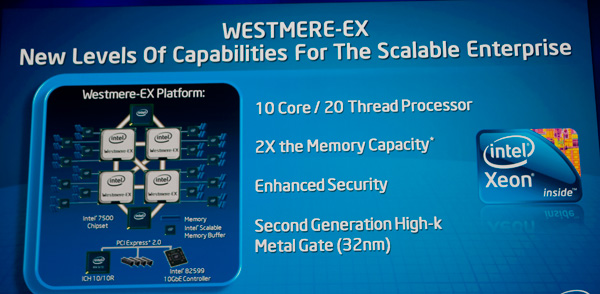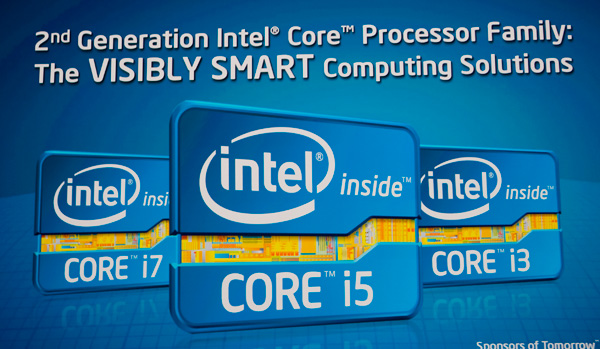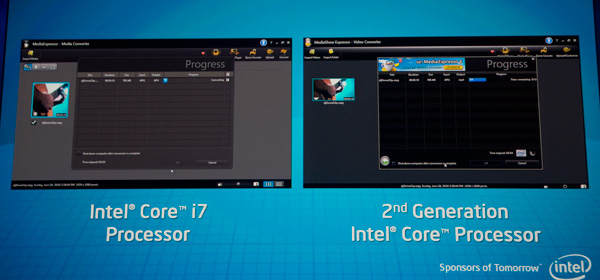Intel Demos Sandy Bridge, Shows off Video Transcode Engine
by Anand Lal Shimpi on September 13, 2010 1:30 PM EST- Posted in
- Trade Shows
- CPUs
- Intel
- Sandy Bridge
Today marks the first day of our IDF 2010 coverage and we just left Dadi Perlmutter's keynote. Keeping up with tradition, Dadi's keynote focused on two of Intel's upcoming microprocessors.
Dadi began his architecture talk with a reference to Westmere EX. The follow-on to Nehalem EX brings the architecture down to a 32nm manufacturing process. The transistor shrink enables Intel to increase core count from 8 on Nehalem EX to 10 on Westmere EX (20 threads).

Westmere EX is socket compatible with current Nehalem EX systems. Along with AES-NI support, Westmere EX also enables support for 32GB DIMMs. Bringing total system memory support from 1TB (64 DIMM slots) to 2TB with Westmere EX.
Sandy Bridge Details
We’re going to hear a lot about Sandy Bridge today. We saw the performance of Sandy Bridge a few weeks ago, but today we’ll find out why it performed the way it did.

Earlier in the keynote, we heard that Ivy Bridge is making its way through the fabs now with production scheduled for 2H 2011
Dadi mentioned that Sandy Bridge has around a billion transistors and that in 10 - 11 years we’ll have chips with 100 billion transistors.
Sandy Bridge brings Intel’s integrated graphics on die as we’ve already mentioned. Now both the GPU and CPU can share the L3 cache, which Dadi indicated resulted in a 4 - 5x increase in GPU performance for data in the cache.

Dadi confirmed that Sandy Bridge would use a high bandwidth ring bus to connect the CPU, GPU and other on-die components to one another.
We also got confirmation that Sandy Bridge will support both CPU and GPU turbo modes.
Officially Sandy Bridge will be called the 2nd generation Intel Core processor, and here are the new logos:

Intel confirmed that Sandy Bridge has dedicated video transcode hardware that it demoed during the keynote. The demo used Cyberlink’s Media Espresso to convert a ~1 minute long 30Mbps 1080p HD video clip to an iPhone compatible format. On Sandy Bridge the conversion finished in a matter of a few seconds (< 10 seconds by my watch).

Dedicated hardware video transcode is Intel’s way of fending off the advance of GPU compute into the consumer market, particularly necessary since you can’t do any compute on Intel’s HD graphics (even on Sandy Bridge).
Given Intel’s close relationship with the software vendors, I suspect we’ll see a lot of software support for this engine when Sandy Bridge ships early next year.
More on Sandy Bridge to follow later today, stay tuned!










18 Comments
View All Comments
ibudic1 - Monday, September 13, 2010 - link
This, is what the doctor ordered. All I need to know now is when sandy bridge ships for laptops. ANAND please ask.ibudic1 - Monday, September 13, 2010 - link
So the exact date for sandy bridge, and while you are there, how about those 25nm SSD's? I've been waiting for both so I can buy a laptop.Drag0nFire - Monday, September 13, 2010 - link
haha. I had the exact same questions. I've been waiting 5+ years to upgrade to a new laptop, and the time is finally coming!Guspaz - Monday, September 13, 2010 - link
Huh? Second generation?But... That means that the Intel Core (which was mobile-only, based on the Pentium M), the Intel Core 2 (solo, duo, quad), and Intel Core i3/i5/i7 (both Nehalem and Lynnfield) are all considered to be the same first generation...
That's patently ridiculous. There is a far greater difference between an Intel Core Solo/Duo (the Yonah core) and the Intel Core i7 (Lynnfield) than there is between the Lynnfield and Sandy Bridge!
mezrah - Monday, September 13, 2010 - link
He was clearly referring to the 2nd generation of the Core (i3/i5/i7) series.Rajinder Gill - Monday, September 13, 2010 - link
Second generation 32nm - first in this instance being Gulftown and Clarkdale. Lynnfield is 45nm.CZroe - Monday, September 13, 2010 - link
And he clearly expressed it wrong, which stuck out to me too.taltamir - Tuesday, September 14, 2010 - link
its INTEL that is expressing it wrong...intel's naming just get stupider by the day
extide - Monday, September 13, 2010 - link
The current generation of CPU's are marketed as the "Core" proessors, as a whole lineup. Have you seen the commercials about "the new 2010 Intel core processors?" Now, intel is calling these cpu's the second generation of that. Even though Core/Core2 were called core, they are separate...XZerg - Monday, September 13, 2010 - link
Wasn't SB supposed to come out in 2010 - as per Intel